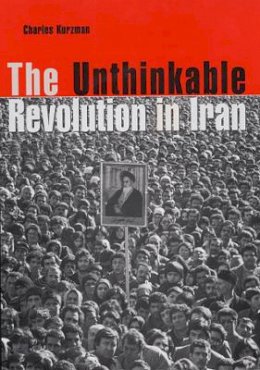13%OFF
Stock image for illustration purposes only - book cover, edition or condition may vary.
The Unthinkable Revolution in Iran
Charles Kurzman
FREE Delivery in Ireland
Description for The Unthinkable Revolution in Iran
Paperback. A top-secret CIA analysis in October 1978 concluded that the Shah of Iran would remain on the throne for the foreseeable future. 100 days later he was overthrown by a popular and largely peaceful revolution. Num Pages: 304 pages. BIC Classification: 1FBN; 3JJPL; HBJF1; HBLW3; HBTV; JPWQ. Category: (P) Professional & Vocational. Dimension: 204 x 147 x 24. Weight in Grams: 244.
The shah of Iran, Mohammad Reza Pahlavi, would remain on the throne for the foreseeable future: This was the firm conclusion of a top-secret CIA analysis issued in October 1978. One hundred days later the shah--despite his massive military, fearsome security police, and superpower support was overthrown by a popular and largely peaceful revolution. But the CIA was not alone in its myopia, as Charles Kurzman reveals in this penetrating work; Iranians themselves, except for a tiny minority, considered a revolution inconceivable until it actually occurred. Revisiting the circumstances surrounding the fall of the shah, Kurzman offers rare insight into ... Read morethe nature and evolution of the Iranian revolution and into the ultimate unpredictability of protest movements in general.
As one Iranian recalls, "The future was up in the air." Through interviews and eyewitness accounts, declassified security documents and underground pamphlets, Kurzman documents the overwhelming sense of confusion that gripped pre-revolutionary Iran, and that characterizes major protest movements. His book provides a striking picture of the chaotic conditions under which Iranians acted, participating in protest only when they expected others to do so too, the process approaching critical mass in unforeseen and unforeseeable ways. Only when large numbers of Iranians began to "think the unthinkable," in the words of the U.S. ambassador, did revolutionary expectations become a self-fulfilling prophecy. A corrective to 20-20 hindsight, this book reveals shortcomings of analyses that make the Iranian revolution or any major protest movement seem inevitable in retrospect.
Show Less
Product Details
Publisher
Harvard University Press United States
Place of Publication
Cambridge, Mass, United States
Shipping Time
Usually ships in 7 to 11 working days
About Charles Kurzman
Charles Kurzman is Professor of Sociology, University of North Carolina at Chapel Hill.
Reviews for The Unthinkable Revolution in Iran
In the world of politics, a true revolution is the perfect storm
rare and uniquely destructive. Can the social scientist comprehend and perhaps even predict the course of such a complex phenomenon? Charles Kurzman takes a cool, dispassionate look at the many explanations of the Iranian revolution and finds them inadequate. Drawing on an impressive range of original research, he argues ... Read morethat mass revolutionary movements become viable suddenly
and unpredictably
as perceptions of potential success acquire popular acceptance. This book is a major addition to the literature on the Iranian revolution
and revolution in general.
Gary Sick, former member of the National Security Council staff, and Adjunct Professor of International Affairs at Columbia University Sociologist Kurzman addresses five familiar sets of explanations about why the Iranian revolution took place
political, organizational, cultural, economic, and military arguments
and finds each valuable but flawed, offering instead an 'anti-explanation' that foregrounds anomaly and characterizes the revolutionary moment as confusing, unstable, and as unpredictable for participants as it is for outside observers. Despite this, optimism is in order; there is, after all, exciting potential in moments in which the unthinkable suddenly becomes thinkable.
Brendan Driscoll
Booklist
When Elias Canetti, the Nobel-prize winning theorist, spoke of a people's 'propensity to incendiarism,' he had in mind one of the most dangerous traits of mass gatherings: their potential for unpredictable combustibility. Iran's Islamic revolution, like many other uprisings, was a consummate instance of this, Kurzman argues, and he continues in Canetti's tradition by using the Shah's overthrow to engage in his own meditation on crowds and power. Kurzman's investigation propelled him to the Islamic republic, where he conducted countless interviews, in an attempt to chart the eddies and undercurrents of one of the world's most complex and sudden social upheavals...The result is a thought-provoking combination of journalism and analysis that offers an atypical juxtaposition of voices: shopkeepers, lawyers and high school students share their views on what happened, as do academics and policymakers.
Publishers Weekly
[Kurzman's] book examines the Islamic revolution in the light of social sciences. It is a valuable insight into what he considers one of the most far-reaching events of the 20th century.
Shusha Guppy
Times Higher Education Supplement
Charles Kurzman has presented a meticulous anatomy of the Iranian revolution and has dexterously treated the anomalies usually inherent in revolutions...The author shifts through revolution theories and shows with pages and pages of documentation and references how they related to the Iranian revolution or missed it. Kurzman's opus is certainly a valuable contribution to the historiography and sociological analysis of an important revolution of our age that led to a large scale politicization of Islam in those parts of the world where this religion prevailed.
Syfi Tashan
Journal of Third Word Studies
Charles Kurzman has produced the definitive account of the Islamic Revolution. No serious historian can write about these events without consulting his 10-page essay on available source material in The Unthinkable Revolution in Iran.
Middle East Quarterly
Show Less


